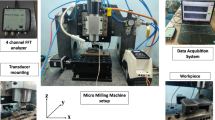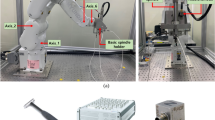Abstract
Machining with robots represents a promising, highly flexible and cost effective alternative to standard machining and hand labour applications when machining mid tolerance soft material end products. One of the most challenging issues is to know the vibration characteristics in milling with the robots which greatly affect tool life. In general the technological bases of tool life expectancy while milling with robot arms are not available or studied. That`s why the purpose of this paper is to investigate the influence of attained vibrations analysis during the milling process and correlated tool wear. Primarily the study is focused on tool wear according to the distance between the milling position and the robot`s base. Results show that increasing distance between the robot's base and the milling position significantly affects tool wear because of the attained vibrations in proportion to the increasing distance respectively. Tool wear has also proved to be greater in comparison to machining with CNC machine and applicable new information for woodworking industry.
Similar content being viewed by others
References
Z. Pan et al., Recent progress on programming methods for industrial robots, in Robotics (ISR), 2010 41st International Symposium on and 2010 6th German Conference on Robotics (ROBOTIK) (2010).
E. Abele, M. Weigold and S. Rothenbucher, Modeling and identification of an industrial robot for machining applications, CIRP Annals — Manufacturing Technology, 56 (1) (2007) 387–390.
J. P. Davim, V. C. Clemente and S. Silva, Surface roughness aspects in milling MDF (medium density fibreboard), The International Journal of Advanced Manufacturing Technology, 40 (1–2) (2009) 49–55.
T. Ohuchi and Y. Murase, Milling of wood and wood-based materials with a computerized numerically controlled router V: Development of adaptive control grooving system corresponding to progression of tool wear, Journal of Wood Science, 52 (5) (2006) 395–400.
G. Kowaluk et al., Examination of tools of different materials edge geometry for MDF milling, European Journal of Wood and Wood Products, 67 (2) (2009) 173–176.
M. Zbiec, Application of neural network in simple tool wear monitoring and identification system in MDF milling, Drvna Industrija, 62 (1) (2011) 43–54.
H. Zhang et al., Machining with flexible manipulator: Toward improving robotic machining performance, in Proceedings of the 2005 IEEE/ASME International Conference on Advanced Intelligent Mechatronics, AIM 2005, July 24 — July 28, 2005, Monterey, CA, United states: Institute of Electrical and Electronics Engineers Inc. (2005).
J. F. C. P. Antunes Simoes et al., Analysis of multi-axis milling in an anthropomorphic robot, using the design of experiments methodology, Journal of Materials Processing Technology, 135 (2–3 SPEC.) (2003) 235–241.
P. Zengxi and Z. Hui, Analysis and suppression of chatter in robotic machining process, Control, Automation and Systems, 2007, ICCAS ′07. International Conference on (2007) 595–600.
M. Kayhen, B. E., An experimental investigation of chatter effects on tool life Proceedings of the Institution of Mechanical Engineers, Part B: Journal of Engineering Manufacture, 223 (November 1) (2009) 1455–1463.
P. Philbin and S. Gordon, Characterisation of the wear behaviour of polycrystalline diamond (PCD) tools when machining wood-based composites, Elsevier Ltd. (2005).
B. Porankiewicz, J. Sandak and C. Tanaka, Factors influencing steel tool wear when milling wood, Wood Science and Technology, 39 (3) (2005) 225–234.
ISO 9427:2003 Wood-based panels — Determination of density.
ISO 16979:2003 Wood-based panels — Determination of moisture content.
KUKA datasheet (http://www.kuka-robotics.com).
ISO 3685: 1993 Tool-life testing with single-point turning tools.
ISO 8688-2:1989 — Tool life testing in milling — Part 2: End milling.
Author information
Authors and Affiliations
Additional information
Recommended by Associate Editor Sung Hoon Ahn
Janez Tratar is an Young researcher at laboratory for machining, Faculty of Mechanical Engineering, University of Ljubljana. His research interests is robotics machining.
Franci Pušavec is an Assit. Prof. at laboratory for machining, Faculty of Mechanical Engineering, University of Ljubljana. His research interests are sustainable machining processes and machining dynamics.
Janez Kopač is a Prof. and head of the laboratory for machining and of the Department for management of manufacturing technologies at Faculty of Mechanical Engineering, University of Ljubljana.
Rights and permissions
About this article
Cite this article
Tratar, J., Pusavec, F. & Kopac, J. Tool wear in terms of vibration effects in milling medium-density fibreboard with an industrial robot. J Mech Sci Technol 28, 4421–4429 (2014). https://doi.org/10.1007/s12206-014-1010-9
Received:
Revised:
Accepted:
Published:
Issue Date:
DOI: https://doi.org/10.1007/s12206-014-1010-9




